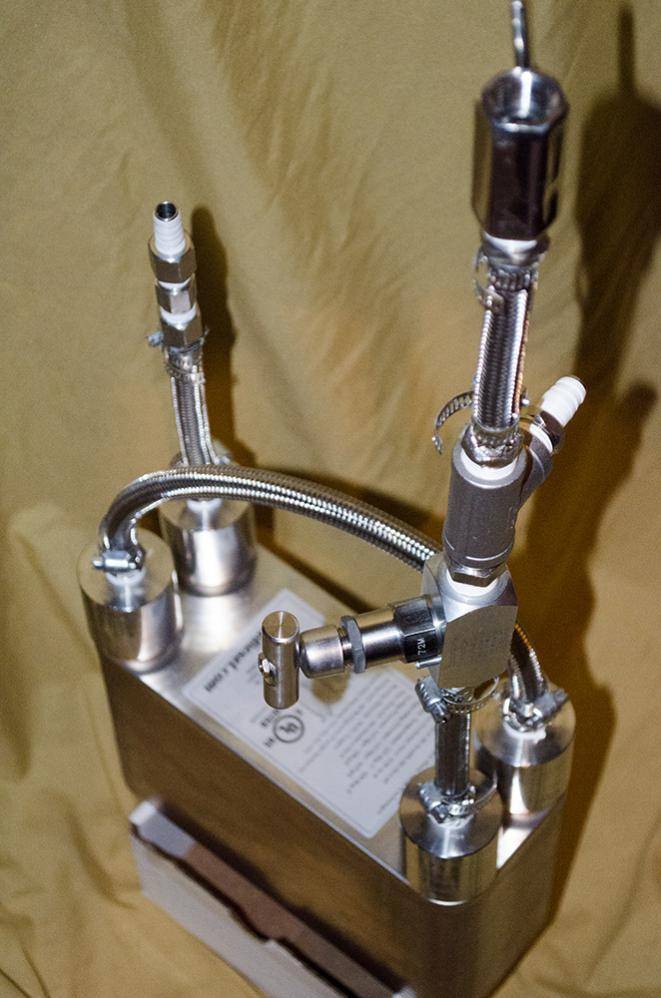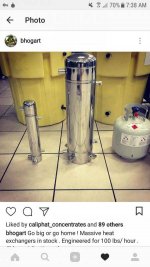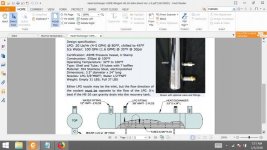Hey IC...Couple Questions for anyone that uses Pure Propane as solvent and has experience with a proper heat exchange to chiller combination. I am looking to purchase a heat exchanger..And I am currently looking at the Bhogart 100lbs an hour unit...which is probably a tad overkill for my system which is probably more around 50~60lb range..but for the price it seems reasonable...however thats only half the solution. My question is...has anybody used this particular exchanger? If so what chiller did you throw at it to achieve our desired results? In my case as I assume most folks case I'm looking for a recovery time of more or less 1 hour. If anybody has an alternative solution..I'm open to suggestions. Any recommendations appreciated. Thanks!
-
Happy Birthday ICMag! Been 20 years since Gypsy Nirvana created the forum! We are celebrating with a 4/20 Giveaway and by launching a new Patreon tier called "420club". You can read more here.
-
Important notice: ICMag's T.O.U. has been updated. Please review it here. For your convenience, it is also available in the main forum menu, under 'Quick Links"!
You are using an out of date browser. It may not display this or other websites correctly.
You should upgrade or use an alternative browser.
You should upgrade or use an alternative browser.
PROPANE Heat Exchanger + Chiller Recommendations
- Thread starter thcnology
- Start date
einsteinlady
Member
What’s the price tag
Originally Posted by Gray Wolf...
GW I stole this from another post of yours..I think my math is right?? and lets assume exhausts at 120F...
The latent heat of vaporization for n-Butane is 165.6 btu/lb, so that converts to about 48.5 Watts per pound.
The latent heat of vaporization for PROPANE is 184 btu/lb, so that converts to about 53.9 Watts per pound.
https://www.engineeringtoolbox.com/butane-d_1415.html
https://www.engineeringtoolbox.com/propane-d_1423.html
https://www.rapidtables.com/convert/p...TU_to_Watt.htm
You have to remove both any heat added by the pump, as well as the heat of vaporization to return it to liquid state at about (31.2F for BUTANE)...((-44F) for PROPANE)
You can measure the temperature of the gas exiting your pump closely enough for our purposes, measuring the plumbing fitting at the pump discharge with a hand held infrared thermometer.
If you subtract (31.2F for BUTANE)...((-44F) for PROPANE) from that reading, you will have your delta T for your calculations.
The specific heat of both BUTANE and PROPANE is 0.39 btu/lb/F, and can be found in the engineering toolbox links above.
It says that it takes 0.39 btu’s per pound for both BUTANE and PROPANE, to raise its temperature 1 degree F.
So if you pump exhaust is 120F, your delta T is 120F – 31.2F= 88 degrees delta T for BUTANE.
So if you pump exhaust is 120F, your delta T is 120F – (-44)F= 164 degrees delta T for PROPANE.
Soooo, 1 lb of n-butane at 88 degrees delta T, requires 88/0.39=225.6 btu to return it to 31.2F.
Soooo, 1 lb of PROPANE at 88 degrees delta T, requires 164/0.39=420.5 btu to return it to -44F.
BUTANE 225.6 btu + 165.6 btu heat of Vaporization = 279.8 btu/lb to remove to return it to liquid state.
PROPANE 420.5 btu + 184 btu heat of Vaporization = 604.5 btu/lb to remove to return it to liquid state.
Using the converter above, that is about 82W per pound for BUTANE.
Using the converter above, that is about 177W per pound for PROPANE.
So ~50lb*82W=4,100 Watts for BUTANE??
So ~50lb*177W= 8,850 Watts for PROPANE??
I think this is right GW slap me if I’m wrong…SMH..I deduce from all this that chilling PROPANE is TWICE as Hard and TWICE as Expensive but I sorta already knew that
GW I stole this from another post of yours..I think my math is right?? and lets assume exhausts at 120F...
The latent heat of vaporization for n-Butane is 165.6 btu/lb, so that converts to about 48.5 Watts per pound.
The latent heat of vaporization for PROPANE is 184 btu/lb, so that converts to about 53.9 Watts per pound.
https://www.engineeringtoolbox.com/butane-d_1415.html
https://www.engineeringtoolbox.com/propane-d_1423.html
https://www.rapidtables.com/convert/p...TU_to_Watt.htm
You have to remove both any heat added by the pump, as well as the heat of vaporization to return it to liquid state at about (31.2F for BUTANE)...((-44F) for PROPANE)
You can measure the temperature of the gas exiting your pump closely enough for our purposes, measuring the plumbing fitting at the pump discharge with a hand held infrared thermometer.
If you subtract (31.2F for BUTANE)...((-44F) for PROPANE) from that reading, you will have your delta T for your calculations.
The specific heat of both BUTANE and PROPANE is 0.39 btu/lb/F, and can be found in the engineering toolbox links above.
It says that it takes 0.39 btu’s per pound for both BUTANE and PROPANE, to raise its temperature 1 degree F.
So if you pump exhaust is 120F, your delta T is 120F – 31.2F= 88 degrees delta T for BUTANE.
So if you pump exhaust is 120F, your delta T is 120F – (-44)F= 164 degrees delta T for PROPANE.
Soooo, 1 lb of n-butane at 88 degrees delta T, requires 88/0.39=225.6 btu to return it to 31.2F.
Soooo, 1 lb of PROPANE at 88 degrees delta T, requires 164/0.39=420.5 btu to return it to -44F.
BUTANE 225.6 btu + 165.6 btu heat of Vaporization = 279.8 btu/lb to remove to return it to liquid state.
PROPANE 420.5 btu + 184 btu heat of Vaporization = 604.5 btu/lb to remove to return it to liquid state.
Using the converter above, that is about 82W per pound for BUTANE.
Using the converter above, that is about 177W per pound for PROPANE.
So ~50lb*82W=4,100 Watts for BUTANE??
So ~50lb*177W= 8,850 Watts for PROPANE??
I think this is right GW slap me if I’m wrong…SMH..I deduce from all this that chilling PROPANE is TWICE as Hard and TWICE as Expensive but I sorta already knew that

Unsure really GW...Lets say hot? Heha! IDK how I'd test that exactly either...
Good job!
HashoftheTitans
Member
Exergy has some baller heat exchangers. Ben at TouchScience sells the best chinese chillers.
Itsgotatail
Member
Lab chillers seem disproportionately expensive considering they are just devices that are taking electricity and using it to remove temperature. I'm surprised we haven't seen more beefy homebuilt solutions. I would imagine that a big window-unit air conditioner plumbed up to a plate style or tube-in-shell heat exchanger could compete with a $20k lab chiller, and could be built for under $2k. I'm thinking about plumbing up a single AC unit to chill both my injection coil as well as my after-pump chiller coil. I have no idea how I'm going to go about this yet. Like what refrigerant I'll use or what temperatures I'll be able to achieve. I was thinking that if I wanted to get really crazy, I could build a cascading system where one AC unit chilled another unit's refrigerant and then THAT refrigerant got my butane down to -50°F. I think I could STILL build this for $3-4k, even with welding fees. From what I've seen, that much money doesn't get much of a pro lab chiller system. Maybe 2HP/1500W at best. I'd like to get at least 5HP or 3800W of chilling power (and a heat exchanger that can efficiently take advantage of that). From what I've seen so far, the $100-200 plate style heat exchangers are the best deal as far as BTUs/hr per dollar and are often rated at 300+psi. Perhaps several of those could just be strung together to reach the desired capacity.
How much does a dry ice manufacturing machine cost (serious question)?
As far the plate exchangers, I have a single one that I submerge in PID controlled hot oil pot for heating nitrogen, but it absolutely destroys my copper coil in efficiency. The plates have a crazy groove system that really increases contact and thus increases heat transfer.

You absolutely could string a bunch of these together and cool as much liquid or gas as needed. Just build/buy an insulated shell, like they sell dry ice in grocery stores, and fill it up with dry ice and glycol or other mixture for maximum efficiency.
So, again. How much does a dry ice machine cost???
As far the plate exchangers, I have a single one that I submerge in PID controlled hot oil pot for heating nitrogen, but it absolutely destroys my copper coil in efficiency. The plates have a crazy groove system that really increases contact and thus increases heat transfer.
You absolutely could string a bunch of these together and cool as much liquid or gas as needed. Just build/buy an insulated shell, like they sell dry ice in grocery stores, and fill it up with dry ice and glycol or other mixture for maximum efficiency.
So, again. How much does a dry ice machine cost???

Itsgotatail
Member
Yes, those are the plate style I'm thinking of, although I'd be running butane through one channel and the refrigerant from the AC system through the other channel. Should be easy enough to find an HVAC tech that can just open up an AC unit, empty the refrigerant, plump this heat exchanger into the loop and refill it with a suitable refrigerant to get down to the desired temperatures.
Itsgotatail
Member
My other option would be to plumb that AC unit to a copper coil sitting in glycol or alcohol and have THAT coolant pump through the plate heat exchanger, but that seems like an unecessary extra step.
Lots of ways to skin a cat. Even if you are running refrigerant through one side of counter flow, you would want to insulate the plates for maximum effect. You could keep plates in a chest freezer and/or use chest freezer full of glycol as a pre-chiller even if using your modified ac condenser approach. Pangea posted some links to some top-shelf ac gear in the 2k-3k range. Edit here - https://www.icmag.com/ic/showpost.php?p=8120920&postcount=22
People also use this tech (ac unit conversion with glycol) to "water-cool" computer chips for bleeding edge overclocking. Tons of DIY youtube videos if you search for those. From what I saw, the real bitch of the process is cutting out the copper condensing coil system from the AC unit without damaging (puncturing the coil).
The simplest approach is to string a bunch of cross-linked plate chillers together, submerge in glycol, cool solution with dry ice or motorized approach to your desired temperature.
How much butane are you talking about?
How much butane are you talking about?
Itsgotatail
Member
I'm using 30-32lb in my system. I should be using a bit more, since I'm using a 4x48" material column (10 liters). But I'm collecting in a 12x12" column with a 3" deep shatter platter on the bottom. This is about all I can fit. I seem to get everything out with just 2.5x volume but perhaps I won't if I significantly drop my injection temps.
30lbs is a lot of gas to do an effective heat transfer. What is your delta T? Mine is around 140F, with a starting temp of 70F and a desired gas temp of 210F. While certainly not an exact reference, my single plate with the sides interconnected, took a residence total time of 60-120 seconds to bring 1lb of gas to my temp, but I use a very slow bleed as part of my process, and this works perfectly for my needs. How fast would you want to heat exchange 30lbs of gas?






